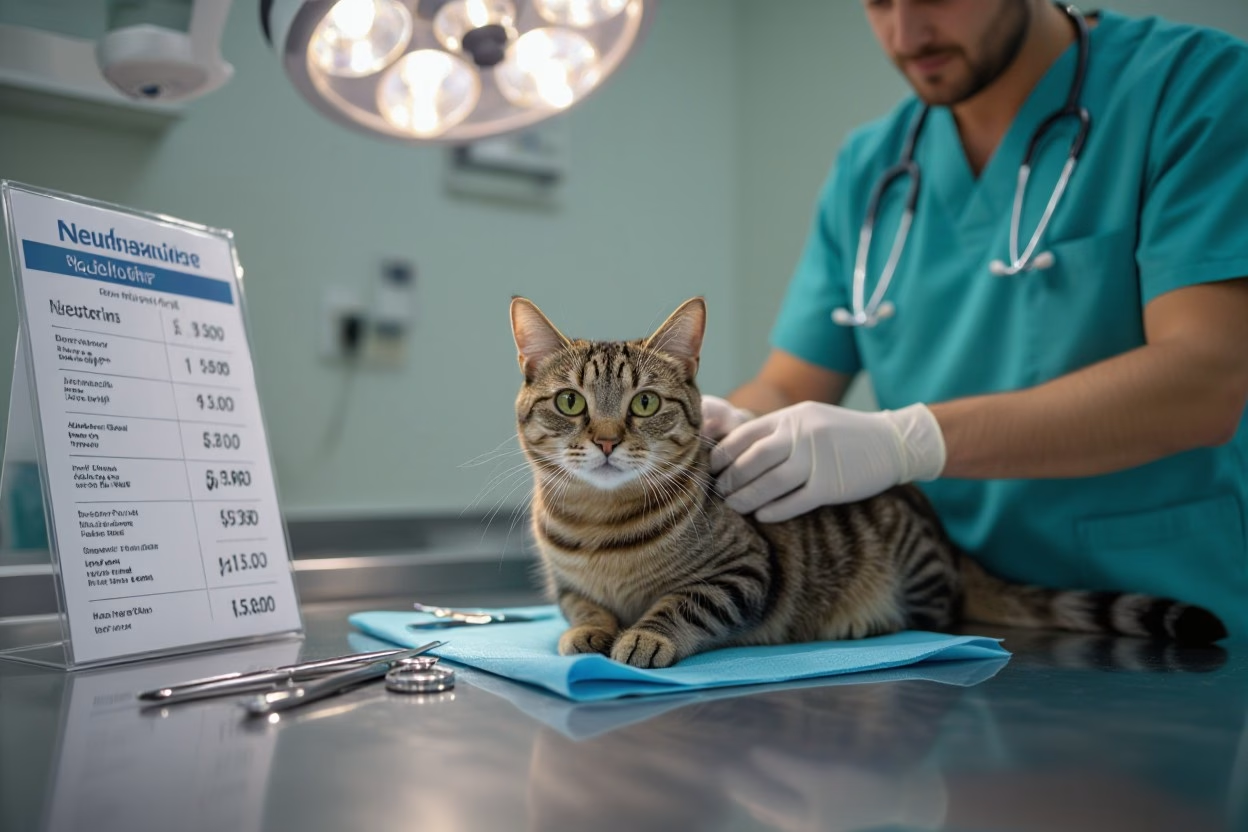The Essential Guide to Cat and Kitten Neutering
What to expect and practical details
You can have your kitten neutered from 4–5 months, with routine castration typically costing £50–£100 and spaying £70–£150 in the UK; YorVet Harrogate/York often schedules a 24–48‑hour check and a wound review at day 7. Expect tiredness and reduced appetite initially, full recovery by 7–10 days, and use a buster collar or suit to prevent licking. Monitor for infection, swelling or unusual lethargy—anaesthetic reactions are rare but call your vet if you see vomiting, severe breathing changes or persistent bleeding. Benefits include less spraying, roaming and fighting.
Demystifying the Neutering Procedure
Procedure details vary by sex and age: castration in males typically takes 5–20 minutes and spaying in females usually runs 20–45 minutes under monitored general anaesthesia. You’ll drop your cat off the same day for an outpatient procedure in most UK clinics. Typical recovery to normal activity is 7–10 days, with most kittens bright and eating within 24–48 hours; complications are uncommon but require prompt veterinary attention.
The Surgical Process: Spaying and Castration Explained
Male neutering involves a small scrotal incision and removal of the testes, often closed with absorbable sutures; female spays use a midline or flank incision to remove ovaries and usually the uterus, with options for laparoscopic spay in some practices for less post-op pain. Pre-op checks may include weight assessment and blood tests for older cats, and anaesthetic monitoring includes ECG, pulse oximetry and temperature control throughout the operation.
Safety and Recovery: What to Expect
Post-op you’ll manage pain with prescribed analgesics (often for 48–72 hours), restrict jumping and rough play, and prevent wound licking with a buster collar or recovery suit. Watch the site for redness, swelling, discharge or wound opening; mild bruising is common, but fever, persistent vomiting, heavy bleeding or severe lethargy need immediate vet review. Most cats require a 7–10 day activity restriction and a wound check if stitches were used.
Analgesia plans often combine an injection at surgery with oral meds at home; follow the exact dosing and finish the course. If tissue glue was used, it usually sheds within 5–10 days and needs no removal, whereas absorbable sutures rarely require a follow-up removal. In a typical case at a local clinic, a healthy 4‑month kitten was eating within 12 hours and resumed gentle play by day 3, fully cleared by the 10‑day check—contact your vet sooner if you spot increasing pain, discharge or wound separation.

Optimal Timing for Neutering Your Cat
Most UK veterinary practices recommend neutering kittens at 4–5 months to prevent first heat cycles, unwanted litters and early behavioural problems. Neutering earlier shortens the window for accidental breeding and often simplifies recovery; male castration is quick with low complication rates and females spayed before first season show a significantly reduced risk of mammary tumours. Local rescue rules or TNR schemes may set different timelines, so check your vet or shelter policy.
The Recommended Age for Neutering: Why Early Is Better
Neutering from around 4 months limits roaming, spraying and fighting in males and reduces long-term health risks in females; evidence shows spaying before the first heat can cut mammary cancer risk by up to ~90%. Kittens under anaesthesia recover faster and tend to bounce back within 24–48 hours, lowering overall complication rates compared with delaying the procedure until sexual maturity.
Exceptions: Adult Cats and Local Regulations
Adult cats may be neutered safely at any age, though older or systemically unwell cats need pre-op assessment; rescue organisations and some local councils often require neutering before rehoming or issue TNR protocols for feral colonies. You should expect pre-surgery checks and possible scheduling differences under these rules.
For adult or senior cats your vet will usually request a pre-anaesthetic workup: at a minimum blood tests (haematology and biochemistry), and for seniors (commonly >8 years) or those with murmurs, an ECG or further screening may be advised to reduce anaesthetic risk. Pregnant queens can be spayed, but shelters sometimes delay or follow specific welfare policies; feral cats are typically handled via Trap–Neuter–Return programmes with same-day recovery and microchipping, while rehoming rescues often insist on neutering prior to or immediately after adoption. Check local regulations, rescue policies, and ask your vet to tailor timing and tests to your cat’s health and lifestyle.
Unpacking the Benefits of Neutering
Behavioral Improvements: A Calmer Cat
You’ll often notice neutering reduces behaviours driven by sex hormones: males can show a 50–70% drop in roaming and fighting, and urine spraying falls significantly. Female heat-calling and escape attempts cease after spaying, easing stress for you and neighbours. Less fighting means fewer bite wounds and a lower chance of FIV transmission. If you neuter at 4–5 months many unwanted behaviours never fully develop, making home life noticeably calmer.
Health Benefits: Reduced Risks and Longevity
Spaying before the first season can lower your cat’s risk of mammary tumours by up to 90%, and ovariohysterectomy eliminates the risk of pyometra, a potentially life‑threatening uterine infection. Castration removes the chance of testicular cancer and reduces bite‑related infections. Neutered cats also roam less, cutting their exposure to road traffic and infectious diseases, which contributes to longer, healthier lives.
Emergency treatment for pyometra commonly requires hospitalisation, IV fluids and surgery; in the UK this can cost £800–£1,200+ for urgent care. Spaying at 4–5 months offers the greatest protection against mammary cancer, while delaying neutering increases lifetime disease risk. By reducing roaming and fights, neutering lowers the incidence of abscesses and trauma, directly improving your cat’s long‑term survival odds.

Understanding Neutering Costs in the UK
Expect typical UK ranges of around £50–£100 for a male castration and £70–£150 for a female spay, with charity clinics sometimes lower; urban practices in Harrogate or York often sit at the higher end. You may pay extra for pre-op blood tests, microchipping or extended monitoring, and pet insurance can cover some fees. After comparing quotes and what’s included, you can choose the best option for your cat and budget.
Breakdown of Average Costs: Male vs. Female Procedures
Male castration is quicker, usually under 30 minutes, which keeps average costs lower; female spays (ovariohysterectomy) take longer and require more anaesthesia and suturing, so prices run higher. Expect routine pre-op checks included in many quotes, but add-ons like bloodwork (£35–£70) or in-patient monitoring raise totals. After getting a detailed estimate, check whether post-op checks and pain relief are included to avoid surprises.
- cat neutering
- neutering a male cat
- spaying a female cat
- cat neutering cost UK
Additional Considerations: Weight, Age, and Health Factors
Overweight cats (for example >4.5–5kg) often need longer anaesthetic and monitoring, which can add a surcharge; senior cats usually require pre-op blood tests and possibly ECGs, increasing costs and time in clinic. Kittens from 4 months tend to have faster recoveries and sometimes lower fees, while unwell or pregnant animals need tailored plans and higher-risk anaesthesia. After discussing your cat’s specific profile, your vet will provide a personalised cost breakdown and care plan.
- kitten neutering
- when to neuter a cat
- cat neutering recovery
- local cat neutering Harrogate / York
For more detail, expect pre-op blood tests to identify anaesthetic risks (common prices £35–£70) and note that obesity increases surgical and recovery complications; emergency interventions or overnight stays can push total costs beyond typical ranges. You should factor in follow-up checks and any required antibiotics or pain meds—these often add £15–£40. After confirming all likely extras with YorVet or your chosen clinic, you’ll have a reliable final cost to plan around.
- cat neutering cost UK
- cat neutering
- spaying a female cat
- neutering a male cat

Post-Neutering Care: Ensuring Your Cat’s Comfort
Initial Recovery: Monitoring Your Cat’s Condition
After surgery, check your cat every 4–6 hours for the first 24 hours: appetite, energy, and the incision. Expect mild grogginess and reduced appetite; give prescribed analgesics such as meloxicam or buprenorphine exactly as directed. Use a buster collar or recovery suit to stop licking for 7–10 days. Contact the vet immediately for persistent vomiting, refusal to eat >24 hours, incision bleeding, gaping, or a temperature over 39.5°C.
Long-Term Care: Follow-Up and Future Considerations
Arrange a wound check at 7–14 days or as your vet advises; many cats show full recovery in 7–10 days. Adjust feeding to prevent post-neuter weight gain—reduce daily calories by 10–20% or switch to a neuter-formula diet and increase play sessions. Neutering often reduces roaming and spraying in males within weeks; if behavioural issues persist, book a vet-led behaviour plan or referral.
Track body condition with a target BCS of 4–5/9 and weigh your cat monthly for three months after surgery; rapid gain signals overfeeding. Spaying before the first heat can lower mammary tumour risk by up to 86%, while castration reduces fighting and FIV exposure. Update microchip and vaccination records at your next visit, and seek veterinary review for lethargy, swollen lymph nodes, or urinary problems beyond two weeks.
To wrap up
Following this guide, you should understand when and why to neuter, what the procedures involve, recovery expectations, risks, and typical UK costs; neutering benefits your cat’s health and behaviour and helps prevent unwanted litters. Talk to your vet to choose timing for your kitten or adult cat, and book neutering at YorVet in Harrogate or York for experienced care and clear post-op advice.
FAQ
Q: What is cat neutering and what do spaying a female cat and neutering a male cat involve?
A: Cat neutering is the surgical removal of reproductive tissue to prevent breeding. Spaying a female cat (ovariohysterectomy) removes the ovaries and usually the uterus under general anaesthesia; neutering a male cat (castration) removes the testicles. Both procedures are routine, performed by veterinarians, take typically 20–60 minutes depending on the cat and technique, and involve short-term anaesthesia and monitoring. Most cats recover quickly when cared for properly.
Q: When should I neuter a kitten or cat—what is the recommended timing?
A: Standard timing for kitten neutering is from 4–5 months of age; many UK practices and rescues offer kitten neutering from around 12–16 weeks. Early kitten neutering reduces the chance of unwanted litters and unwanted sexual behaviours, though neutering can be done safely in adult cats too. If you have a rescue, local shelter rules or adoption contract may require earlier neutering—discuss options and timing with your vet.
Q: What are the benefits of cat neutering for health and behaviour?
A: Benefits of cat neutering include preventing unwanted litters and reducing spraying, roaming and fighting (especially in males). Spaying lowers the risk of pyometra and greatly reduces the chance of mammary tumours if done before first heat; neutered males are less likely to roam and be injured. Neutering can also reduce bite-related disease transmission (e.g., lowering FIV risk via fewer fights) and often leads to calmer behaviour in many cats.
Q: What does cat neutering cost in the UK and are there discounts or insurance options?
A: Cat neutering cost UK averages: male cat castration roughly £50–£100 and female cat spaying roughly £70–£150. Prices vary by clinic, cat weight, age and health status. Many practices, charities and clinics offer low-cost schemes or vouchers; pet insurance may cover part of the cost depending on policy terms. Contact YorVet for a tailored quote and available packages at our Harrogate and York branches.
Q: What should I expect after cat neutering and what are the risks during cat neutering recovery?
A: After surgery expect tiredness and reduced appetite for 24–48 hours, mild soreness and a small incision site. Use a buster collar or recovery suit to stop licking. Wounds may be closed with stitches or surgical glue; limit jumping and vigorous play for 7–10 days. Follow-up checks may be advised. Risks are low with a professional vet but can include mild swelling, wound infection, or an adverse reaction to anaesthesia; concerns about growth from early neutering are rare—discuss specific health or breed questions with your vet. For local cat neutering Harrogate / York, book with YorVet to arrange assessment and a safe, supported recovery plan.
